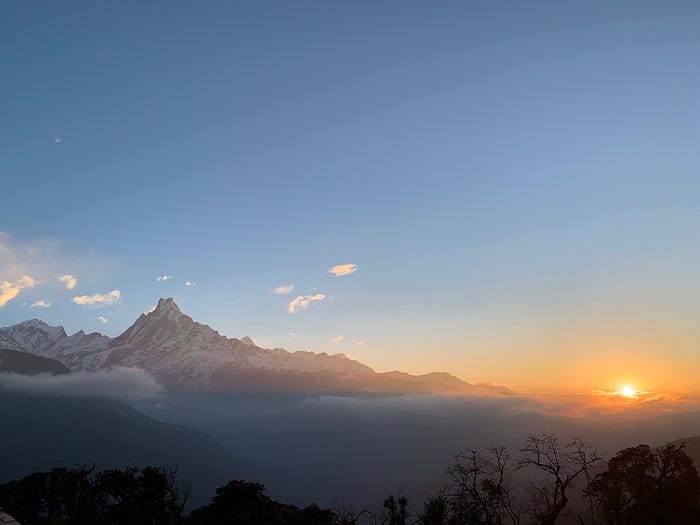Interim 2019: Ghorepani/Poon Hill Trek in the Annapurna Himalayas
Each February, the high school at the Singapore American School closes for a week. All faculty and students participate in the Interim Semester, either in Singapore or abroad. I traveled with 20 students and 1 co-teacher to Nepal, trekking through foothills of the Annapurna Himalayas on the Ghorepani/Poon Hill trek. Here is my experience on the trip!
(All photos were taken by me, using a 2018 iPhone XS Max.)

After flying from Singapore to Kathmandu, we spent the first night at a hotel in Kathmandu. The trek is to the west of Kathmandu, so the next morning we flew — for 23 minutes! — from Kathmandu to Pokhara. To reach our initial trekking point, we took a bus ride from Pokhara; this was one of the most difficult bus rides I’ve ever experienced. To get a feel for the ride, please imagine a winding country road. Now make the road go up and over a 1000-meter hill, with many switchbacks along the way. In addition, make the road dirt — but not just dirt, add muddy ruts and dips for small streams. Finally, make the journey three to four hours, bouncing and swaying the entire ride. My Fitbit was confused about the bus ride — it characterized the bus ride as an outdoor bicycle ride! Fortunately the bus driver was excellent, so we survived the bus ride.

After reaching our initial trekking point, we began to hike. The day was beautiful, with temperatures in the 60s (Fahrenheit) and scattered clouds. Although we could not see the Annapurna mountains, we knew they were near; our excitement was building as the day went along. Unfortunately, it was too cloudy to see the mountains as night approached, so we had to wait until the next day.

When we awoke the next morning, we were in shock at the scale of the mountains! The sky was completely clear, providing a stunning sense of the peaks — they seemed fake, but were instead massive! We joked that the scene looked like someone had photoshopped the mountains into a picture — or that there was a green-screen and we were simply looking at an image. Fortunately neither of these were true; instead, we marveled at the mountains, smiling with giddiness every time we looked at them.




After admiring the size and beauty of the mountains, we began our second day of trekking. This was a relatively easy day of hiking, with some elevation changes. Although we walked through a beautiful old-growth forest, the mountains were ever-present — a break would appear in the trees, with a stunning view of a mountain.

As we gained elevation, we saw snow! This was exciting for us all, but especially exciting for several students who had never before seen snow. We stopped in a clearing, having a massive snowball fight; some students also made snow angels!

After arriving in our camp, we had our dinner and bedded down for the night. We slept in tents on the ground, with a sleeping pad and bag; this completed the authenticity of the trek (haha). I am not used to sleeping in a tent — when my wife and I travel, I insist on doing day hikes with a warm room and shower waiting at the end of the day. Sleeping in a tent — and not showering for four days — was for me an area of growth. I became used to sleeping in the tent by the end of the trip; I can now see why people enjoy this style of traveling.
As we awoke the third morning of trekking, we were treated to another stunning sunrise. There were a few more clouds than the second day, but this heightened the ephemeral quality of the scene.


The third day of trekking was the most difficult due to the length of hike and elevation change. The hike begins with a 500-meter descent down to the bottom of a gorge, then a 700-meter ascent to the top of the other side of the gorge! The descent was made more difficult because of snow and ice; to avoid sliding, we wore elastic crampons on the bottom of our shoes. If you are trekking without a guide during a time when there could be snow and ice, I would highly recommending having the crampons — they make hiking in snow and ice significantly safer and easier.
After reaching the top of the other side of the gorge, we took a break and admired a lovely valley. There was a steep drop on one side of the path; although this made me a bit nervous as the students and I were walking, everyone successfully navigated the path.

The next section of the hike was our most difficult of the trek. Reaching the peak of Thapla required a hike up a gorge; however, the gorge was covered in over a foot of snow. We attached the crampons to our shoes and began the ascent, using our hiking poles for stability. The path had many switchbacks and steep ascents, but we successfully reached the top of the gorge!

After stopping for lunch, we pushed onwards towards Ghorepani — crossing the top of Thapla on the way to Ghorepani. A cloud had engulfed the peak, reducing visibility; the cloud would occasionally break, providing a beautiful view of the surrounding area.

The town of Ghorepani is at the base of Poon Hill; on a clear day, this hill provides a panoramic view of the entire Annapurna Himalayan mountain range. The intention was to hike before sunrise to the top of Poon Hill, watching the sunrise over the Annapurna range. However, nature had other plans — more snow! According to our guide, there had not been snow in the middle of February in Ghorepani for nine years. Although this was a surprising twist, our students took it in stride. We checked with the guides to ensure that we could safely hike Poon Hill, starting after breakfast instead of before sunrise. Although there were some clouds, we were rewarded with a wonderful view of the Annapurna range. We also celebrated our accomplishment of hiking to our highest point; Poon Hill is 3210 meters.




The clouds cleared on the way down, leading to an excellent photo opportunity.

For the next day-and-a-half, we hiked downhill to our final trekking point. The hiking on our last day (from Ulleri to Hille) is steep, uneven stone stairs; I am glad we went down these stairs instead of up the stairs. I attempted to greet several people with a “good morning” as we passed, but those going up the stairs responded with blank stares or grunts.
It was bittersweet to say goodbye to our porters, cooks, and guides; we appreciated their work over the four days. We used Hiuchuli Treks for the trip; the company was great. Everyone helped us have a safe and fun trek — a big thanks to our guides Hari and Budhiman. If you are planning a trek anywhere in Nepal, I would highly recommend them!


After a bumpy bus ride to Pokhara and a flight to Kathmandu, our last two days were spent in Kathmandu. We explored several cultural areas in the city, including Hindu/Buddhist temples and the Boudhanath. Our guides provided great explanations of the rich and varied history of Kathmandu, which increased our cultural awareness of Nepal and its people.
A final note: I am proud of the way students handled themselves during the trip. Although many of them did not know each other before the trip, they bonded well through playing cards and sharing stories. Students did not complain about the trekking conditions, encouraging each other when the hiking was difficult and sharing supplies when we were camping. Students were willing to do what the co-teacher and I asked of them, including a talent show on the last night of the trip! It was a pleasure getting to know each student; this is a trip that we will remember for many years.
